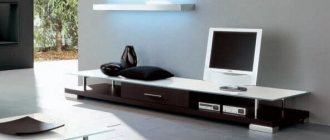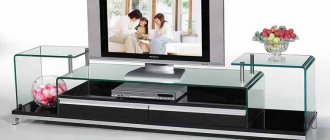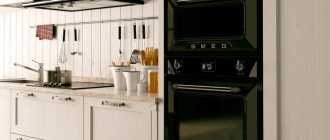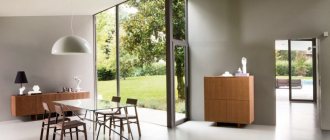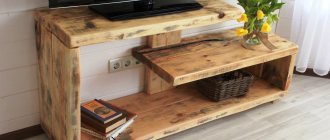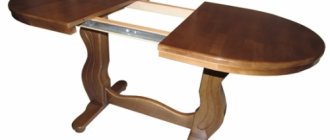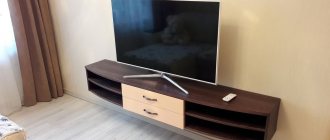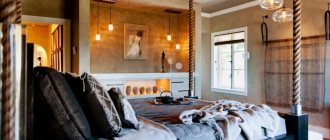Making your bathroom beautiful, comfortable and functional is not so difficult if you pay more attention to the choice of plumbing fixtures and furniture. For example, a hanging cabinet with a sink can be an interesting highlight that will not only fit seamlessly into any design, but will also become a stylish decoration for the room.
A wide range of models allows you to choose this element of the interior to suit every taste and budget, and not too complicated installation and the presence of all the necessary fasteners make installation accessible to DIYers.
In this material we will talk about what hanging cabinets for bathrooms are, and what to look for when choosing. We will also tell you the subtleties of installing suspended structures.
What is special about a hanging cabinet?
When considering wall-mounted bedside tables, it is worth understanding that the main features relate to ease of use. There are also a number of decorative nuances that should also be taken into account. Let us list the advantages of such furniture.
- The cleaning process is greatly simplified. Under the hanging bedside table you can wash the floors freely and without moving it. Any housewife will appreciate this advantage.
- Efficient use of space. Since it does not take up space on the floor, you can place a trash can or laundry basket under it in the bathroom. In the nightstand itself you can store household chemicals, essential items, and bed linen (in the bedroom).
- The cabinets can have an unusual design, which will give the room originality. You can choose an option that completely suits your interior.
- Such furniture has relatively miniature sizes. Therefore, it can be used even in small rooms, without losing useful space.
- There are several varieties available to suit different needs. You should choose it based on your intended use.
Purpose and functions
In fact, a hanging bedside table has a number of advantages and functionalities.
This is a mini-locker that is always at your side, literally at hand. From here you can get everything you need at the right time, and also store there:
In addition to practicality, cabinets also carry a solid aesthetic function, acting as an element of room decor.
Types of hanging cabinets
For TV
Often a hanging cabinet is used to install a TV. There is furniture specifically designed for installing TV receivers. They may involve placing the TV on the stand itself or hanging the screen on the wall. In the latter case, the cabinet is installed as auxiliary furniture.
The standard frame consists of:
- side panels;
- horizon (top cover);
- bottom;
- back wall.
Occasionally, drawers or shelves can be arranged.
Various materials are used in production:
- varieties of particle boards (fibreboard, OSB, MDF, chipboard), as well as varnished types (LMDF, LDSP);
- plastic;
- tree(array);
- glass;
- metal.
Bedside tables can be made from the same material or combined.
A modern TV stand can have different sizes. This factor allows you to optimally select furniture for any room.
It is worth paying attention to the way the wires are placed. Niches for wiring are practically not used. Typically, wires are placed openly or by hidden wiring in the walls.
When choosing fasteners, you should take into account the total weight of the product and the TV. The fastening and the wall must withstand the load with a reserve. The following types of fasteners are used:
- anchor bolts;
- furniture canopies;
- special corners.
Make sure the load is evenly distributed.
When choosing equipment, you should consider what you plan to store in the cabinet. If you intend to store books or decorative items, then you should choose open bedside tables. If you purchase furniture with closed shelves, there are no requirements for stored items.
The equipment may include additional niches for equipment and household appliances. In some cases, additional lighting may be installed. Lighting makes the cabinet more decorative. It’s good if there are sockets, but if necessary, install them yourself. In some versions, niches are made for dishes or decorative items.
Under the bathroom sink
In bathrooms, cabinets combined with a sink are installed. This approach allows you to combine two functional items and save space. This is useful for small bathtubs and restrooms.
It is important to choose the right material. It is worth remembering that the wall-mounted cabinet in the bathroom is constantly exposed to moisture. Here is a list of common materials:
- MDF. It is considered one of the best, due to the density of the structure. But it cannot be considered a panacea.
- Varnished chipboards (LMDF, LDSP).
- Chipboard and fiberboard can only be used if additional protection is applied.
- Metal. It is better to use stainless steel or other types that are resistant to corrosion.
- Plastic. Almost completely immune to water.
- Hardwood. Must be treated with antiseptics.
Separately, it is worth considering the mounting features. Hanging bathroom cabinets have their own characteristics.
- If the installation is on a standard brick wall, you can use regular anchor bolts.
- Plasterboard partitions make it possible to strengthen the cabinet using long bolts and nuts.
- If the wall is made of soft material, you should use butterfly anchors.
When choosing a mounting method, you need to take into account the need to drain water from the sink.
Shelves and drawers are usually placed inside. They are used for storing household chemicals and personal hygiene items. The combination of shelves and drawers is selected individually. The boxes are equipped with rollers.
In practice, the following types of shells are used.
- Mortise. Installation is carried out by cutting into the tabletop.
- Overhead bowl. The entire sink is located above the surface of the top cover.
- Furniture sinks. These are cabinets with a built-in sink; there are one or two wings. Occupies the entire upper surface.
Bedside models
Many people prefer to use bedside hanging options in their bedrooms. They perform several functions at once.
- A table for placing a phone, book and other items.
- Mini closet for storing hosiery and underwear.
An important feature of bedside tables for the bedroom is decorativeness. They should look good and fit into the overall interior. Another distinctive feature is its compact size.
The bedside wall cabinet has drawers and shelves. This allows you to comfortably store a variety of small items in it.
It is made from almost all furniture materials, but metal and glass are rarely used. Standard sizes are 40-60 cm in width, 30-50 cm in depth, and 20 cm in height. This is the most common footage, but there are other options.
To the hallway
For hallways, almost standard hanging models are used. The main difference is the presence of inclined or mesh shelves that are designed for shoes. There are also built-in drawers. They store gloves, hats and other small wardrobe items.
Usually the color is selected taking into account the general color scheme of the room, this will allow the bedside table to optimally fit into the interior. There are no special differences from other types here. All the same materials are used for creation.
Installation technology
Let's look at the features of installing washbasins for a bathroom with a hanging cabinet.
Necessary tool
To do the work yourself you will need the following tool:
You also need to study the manufacturer's instructions and check the package contents. The standard kit includes a sink, an assembled hanging cabinet, and fasteners. The mixer and siphon most often need to be purchased separately.
Note! The included hardware is suitable for concrete walls. If the equipment is installed on walls made of lightweight concrete (foam block, gas block, gypsum boards, etc.), it is necessary to use special dowels, which are additionally screwed into the concrete after drilling the hole.
For fastening into drywall, a special fastener is also used - Molly dowel.
Attaching a wall-hung sink and cabinet
The installation procedure for a self-supporting sink with a hanging cabinet is carried out in the following sequence.
Step 1
Markings are made on the wall. The installation height of the washbasin recommended by current joint ventures is 800–850 mm, but can be changed up or down taking into account the average height of all family members. This is one of the advantages of hanging cabinets under the sink - they can be installed at any height.
Marking includes the following steps:
We mark the attachment points of the sink, having previously measured the center-to-center distance between the holes.
Important! All marks are made using a building level so that the sink is installed strictly horizontally.
Step 2
Then, using a drill of a suitable diameter, holes are drilled for installing dowels in the wall.
Plastic dowels are installed into the drilled holes, into which pins are screwed for hanging the bowl.
Step 3
The washbasin is hung on studs and secured with nuts through plastic eccentrics, which serve to level the bowl and protect it from excessive clamping.
When the sink is secured, its horizontal level is checked. If it is necessary to adjust the horizontal, to do this, loosen the fastening nut by 1.5–2 turns. Fine adjustment is carried out by a plastic eccentric, which is turned with a wrench. After leveling the sink, the nuts are tightened again.
Advice! While the bottom of the washbasin is not covered with a box, it is recommended to install a mixer and a siphon, as well as connect to the pipes, since this will be more difficult to do after hanging the cabinet.
Step 4: installation of the cabinet
The hanging bedside table is mounted in the following order:
Step 5: Adjusting the Nightstand
Fine adjustment of the position of the cabinet relative to the sink and the wall is carried out using two screws located on the front of the decorative cover of the anchors:
Adjustment of fit to the wall.
Types of fastenings for wall-mounted cabinets
There are several ways to attach hanging furniture. You should choose a specific one taking into account the features of the wall, as well as the weight of the bedside table. Let's look at all the options in a little more detail.
- Anchor bolts. The oldest option. It doesn't always look aesthetically pleasing. Used on brick and concrete walls. Bolts can support heavy furniture weight.
- Furniture canopies. Currently the most common method. Can be used on all types. This mount is suitable for almost any wall. One canopy can support up to 120 kg, but in any case, at least two canopies are used at the same time. The more evenly the load is distributed, the better.
- Mounting strip. This is how nightstands are mounted in bedrooms. The model should not be too massive. They hang it from the bar using special hangers.
- Butterfly anchors. Used to work with soft wall materials.
- If the partition is thin, you can use angles and bolts for fastening. To do this, drill holes through and insert long bolts into them.
When hanging, you should always calculate the dimensions accurately. Consider the placement height. For horizontal leveling, it is most convenient to use a laser level.
Clearly horizontal
When installing wall-hung TV stands and other types of wall-mounted furniture, difficulties often arise with maintaining a strictly horizontal level.
This is especially difficult to achieve when using traditional hinged hinges. But during the operation of furniture, failure to maintain the horizontal position leads to skewed doors and other problems. This is another reason to use adjustable awnings. In combination with the mounting strip, they ensure that the furniture is level and can withstand heavy loads. Additional advantages of adjustable awnings are:
General selection criteria
Frame - dimensions and materials
The frame consists of four elements. The base consists of the lower and upper horizontal surfaces; they are connected to each other by two side walls. The back wall is usually attached to the frame last. The standard shape is rectangular. But, in principle, the form can be different. There are square, oval and other varieties.
The size range depends on the destination, as well as on the shape of the cabinet. Let's look at the most standard rectangular options.
- Narrow. Usually provided complete with other furniture. The width rarely exceeds 35 cm, and the height can reach a meter.
- Wide cabinets. Most often used in living rooms. The minimum width is 1.2 meters, the maximum can reach 3 meters. The height and depth usually do not exceed 50 centimeters.
- Tall. For them, the standard is considered to be a height of 80 cm, with a depth of 45 cm. The width is not regulated, but according to unspoken rules it cannot be less than the height.
The material is selected based on the installation location. For the bathroom it is better to choose moisture-resistant materials; for the living room this moment has only stylistic significance. Here are the most common materials:
- Chipboard and fibreboard;
- Lacquered boards;
- Plastic;
- Metal;
- Tree;
- MDF.
Treatment and coating depends on where the cabinet is located. For baths and hallways, it makes sense to use moisture-proof materials for finishing.
Internal filling
Shelves and drawers are traditionally placed inside. In the case of drawers, be sure to use roller guides, this way they can be pulled out with minimal effort.
You can store almost any thing in wall cabinets. You can place whatever is convenient for you there. It is optimal to store those items that you will use near it.
Facades - structures and opening mechanisms
The facade plays a significant role in the choice. The following types are distinguished:
- Whole. This is a single canvas without slits. Often called "deaf";
- Slotted. Provides a slot for decorative elements;
- Made. The sash leaf is assembled from segments of different texture and color. To add rigidity, a double-sided thin aluminum profile is used;
- Frame. All sides of the door are edged with a plastic or aluminum profile. Very reminiscent of a photo frame.
The following systems for opening facades are also distinguished:
- Swing. The door strips are attached to the body using furniture hinges. Reliable system. Does not like sudden jerks or pressure. When open, it takes up quite a lot of space;
- Folding. The principle is the same, but the loops are moved down. The door swings outwards and downwards. Installation of side holders with position locks is provided;
- Retractable. This is a traditional drawer system. Equipped with rollers with narrow guides. Take up a lot of space when opened;
- Sliding. The doors are fastened in pairs using hinges. When opened, they fold into the shape of a book. Upper roller stop.
Tabletops
Countertops allow you to safely use the top panel of the cabinet. They come in several types:
- Classic straight line. This is a familiar tabletop without any frills;
- Curly. May have the most intricate contours;
- With integrated sink. It is equipped with a bowl under the sink, which is an integral element of the countertop and is made of the same material as it.
Sizes and shapes
Typically, a hanging cabinet includes 1-2 drawers, a top tabletop and an open shelf. You can vary the number of drawers and shelves at your discretion. Some people like completely open models, others prefer to have only a top tabletop, and the rest of the space is occupied by drawers.
To make a hanging bedside table look good in the interior, you need to determine the optimal dimensions. Usually they are selected based on the dimensions of the sleeping place, that is, the bed.
There are no strict standards, since everything in the interior is individual. But there is a typical width, which ranges from 40 cm to 60 cm, and it is recommended to choose a depth in the range from 35 to 50 cm.
The structures should not be made too deep, otherwise access to the sleeping area will be complicated. They shouldn't be tall either. Otherwise, the cabinets will rise greatly relative to the bed, which will create an imbalance.
Styles
External individuality will be given by design in a certain style. This affects the appearance and outline of the silhouette:
- Provence. This style is often called "French countryside". It has soft smooth contours without right angles. The decor is modest, mostly handmade. Favorite colors are white, pale pink, lilac, gray;
- Classic. This style harmoniously combines straight lines with rounded corners. Decor is used sparingly. At the same time, he is quite strict. But furniture in the classic style cannot be called ascetic. This is the golden mean. The most favorite material is wood of all shades;
- High tech. These are airy structures made of chromed steel and all types of furniture glass. The use of bright, durable plastic is allowed. The style involves extravagant silhouettes and bold decisions;
- Minimalism. Everything is strict and simple. Correct lines with almost completely absent decor. The natural pattern of the material comes first;
- Ethno. The style involves the manufacture of furniture in strict accordance with national characteristics. It could be wood “lace” with an Arabic twist or a strict cabinet made of rough boards with the style of the north of France.
Installing a hanging cabinet will add lightness and airiness to your interior. At the same time, the functionality of the furniture is fully preserved.
Advantages and disadvantages
Let's start with the positive qualities. They are as follows:
But you shouldn’t forget about the shortcomings either.
And they are here too. We are talking about the following disadvantages:
If you take high-quality furniture and use strong fastenings, then the bedside table should not fall.
Here everyone must make the final decision for themselves.
Hanging bedside tables benefit from their original appearance, practicality in terms of cleaning and other obvious advantages. But again. Where you hung the furniture is where it will be in the near future. This requires carefully selecting the installation location in advance.
What do you think are better bedside tables, wall-hung or floor-standing with legs? Why are you for this or that option?
Share your opinion in the comments. If you have anything to add to the material, be sure to write.
Thanks everyone for your attention!
Subscribe, leave comments and ask relevant questions! Tell your friends about us!
Source
Required Tools
Since installing a sink is not a very complicated process, you don’t need too many tools for this:
- drill or hammer drill. It will be necessary to drill holes in the wall;
- screwdriver or screwdriver. Insert dowels into the holes and tighten the brackets with screws;
- building level. Make even markings;
- tape measure and pencil. Measure the required height;
- hammer. For driving dowels;
- gun for a bottle of sealant. Seal the seams.
Here, in principle, is the entire simple set of tools for fixing the washbasin. Read on to find out what the height standard for installing a sink in a bathroom is.
The following video will tell you what you need to have with you before installing the sink:
https://youtube.com/watch?v=AVjqVh9FW5o
Some practical tips
When choosing a cabinet for a small bathroom, pay attention not only to the dimensions of the body, but also to the span of the door and the reach of the drawers. There should be enough free space in front of the furniture to open the doors without interference without touching nearby objects.
The color and finish of the cabinet should be in harmony with the wall cladding and the overall interior design. If you are not sure that you can independently choose furniture of a suitable shade and style, choose a neutral white color and a laconic, discreet finish. If the cabinet will hide plumbing, make sure that the pipes can be easily reached for repairs if necessary. Find out in advance whether the sink siphon will interfere with the drawers or shelves of the selected cabinet model.
Design
When choosing furniture for any room, you need to pay attention to the appearance of the furniture. It must match the design of the room
This is not difficult to do; it is enough to know some of the features of various styles in the interior. For example, for a room designed in a classic style, the following are perfect: a marble countertop, a porcelain sink, a natural wood cabinet with elegant legs. A gold-plated faucet will complement this luxurious interior.
For those who want to create a more modern, airy style, we recommend turning your attention to glass models of cabinets. It is better to choose fittings for furniture with a sink in a different color that does not match, but is in harmony with the color of the furniture
For example, if the cabinet is light, then it is better to choose handles for it in dark shades, but if the cabinet is dark, then select elements in light shades. Thus, if you decide to buy a cabinet with a sink, then you need to do it carefully and with love, so that the bathroom becomes not only comfortable, but also cozy. Allow yourself to safely experiment with different styles, having first familiarized yourself with their features.
Important nuances
Attaching the cabinet and sink to the wall is advisable if it is strong enough. In other cases, it is important to use a supporting frame. The installation height of the washbasin is selected individually, the average range is 80–85 cm. To make the sink comfortable for children to use, you can install it lower, and higher for tall people.
Plain paper will help to identify minor leaks after installing the washbasin (or make sure there are no leaks). It must be placed under the threaded connections and left for half an hour. If the paper remains dry, everything is fine. If wet spots appear, disassemble the connections and repair any leaks.

